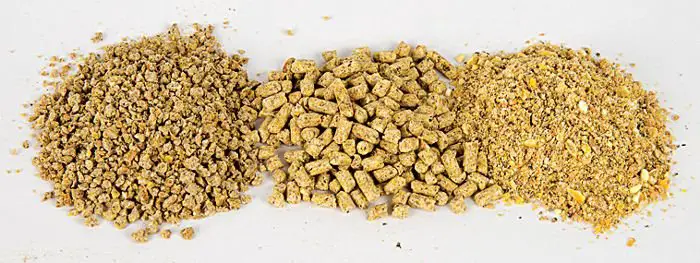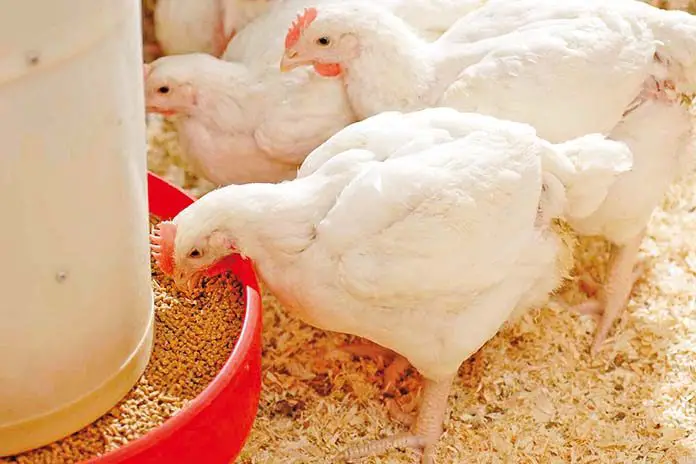Raising broiler chickens can be equated to formula one racing as every second counts if you are going to run an efficient operation. Broilers are bred to efficiently convert feed into meat which is their primary product as they are not raised to produce eggs. Feed types for broilers should aim to provide the best nutrition for the chickens to reach their full potential. However, a delicate balancing act needs to be achieved if the feed ingredients or mixed feeds are to perform in the operation as the feed is the fuel for the fast growing chicken.
Contents
Starter Broiler Feed
Starter broiler feed is typically for the first 10 days of broiler chicks ranging. This type of broiler feed is essential for broilers as it is a protein dense variety chicken feed designed to meet the nutritional requirements of the first stages of a chick. Mash is normally suitable for baby chicks, as it is easy to digest. Crumble is also a stress-free variety of broiler feed that is slightly easier to manage than mash. There is relatively high protein content in the first phase of their lives usually 30-40% which helps chicks grow playfully. Baby chicks can live comfortably on a diet of starter and water for the 2 weeks of their life before progressing onto grower feed. However it’s imperative that a keeper phases out the starter feedstuff once they are 2 weeks old, otherwise the excess protein can cause their liver to damage.
Grower Broiler Feed
After the broiler chick starter feed, from 11-24 days, the young broilers are put on a lesser protein diet to slow growth and allow strong bones and adult body weight to form. The dietary requirements for a broiler chicken between 11-24 days old is very different from a baby chick. Essentially this broiler feed type contains protein content that is between 16-18% but has less calcium than regular layer food. In general, the broiler grower feed supports the continuing growth of your broilers chickens without giving them with excessive vitamins and minerals that are more suited for fully grown hens.
Finisher Broiler Feed
The finisher pack is sorely designed to give the chickens a good grip and health before slaughter. At this stage they are expected to gain vividly good weight up to the day of slaughter, thus from 25 days up to slaughter day. Minerals and vitamins are greatly required for supreme performance. Besides these daily rations, you can give your broiler bird supplements and treats. At this stage broilers have a strong digestive system and are even able to swallow big grains of pellets which have a high protein. Water is greatly important as it helps in maintaining a good digestive system. The finisher feed is the last type of broiler feed given to the birds before they are slaughtered.
Broiler Phase Feeding programs
Grain prices continue to increase and hence increasing the cost of broiler meat production, to increase efficiencies we need a supply of relevant nutrients at the right time. To benefit from the genetic potential of the broiler, feeding phases have been devised from 2 to 5 phases. Broiler diets can comprise a pre starter, starter, grower, finisher and withdrawal diet which does not contain any antibiotics to avoid these entering into the human food chain.
Nutritionists have developed broiler chicken feeds with varying levels of nutrients to feed different stages of growth therefor producing meat in the most efficient manner possible. In most cases the average diet works out to be quite expensive if fed for the whole period as with phase feeding, the feed normally reduces in price from starter to finisher saving the farmer lots of money. 2 phase feeding programs are fast become a thing of the past so here we will share an example of a 3 and 4 phase broiler feed program .
Table 1: Broiler 3 phase feeding
| Starter | Grower | Finisher | |
| Age (days) | 0-10 | 11-24 | 25- Slaughter |
| Energy (Mj) | 12.4 | 12.8 | 13 |
| Crude Protein (%) | 23 | 21.5 | 19.5 |
| Lysine (%) | 1.32 | 1.18 | 1.08 |
| Calcium (%) | 0.95 | 0.75 | 0.65 |
| Available Phosphorus (%) | 0.5 | 0.42 | 0.36 |
Table 2: Broiler 4 Phase Feeding
| Starter | Grower | Finisher 1 | Finisher 2 | |
| Age (days) | 0-10 | 11-24 | 25- 39 | 40- Slaughter |
| Energy (Mj) | 12.4 | 12.8 | 13 | 13.1 |
| Crude Protein (%) | 23 | 21.5 | 19.5 | 18.0 |
| Lysine (%) | 1.32 | 1.18 | 1.08 | 1.02 |
| Calcium (%) | 0.95 | 0.75 | 0.65 | 0.60 |
| Available Phosphorus (%) | 0.5 | 0.42 | 0.36 | 0.34 |
Mash vs Pellet Broiler Feeds
Due to the fact that chickens are grain feeders, traditionally all chickens were feed a course mash to try and simulate their wild diets. Feeding of both mash and/or pellet broiler feeds to chickens has its advantages and disadvantages but in the context of broilers we will focus on the advantages of feeding a pellet feed. A mash broiler feed is basically a mixture of the proportioned ground raw materials with no further processing, while pellet broiler feed is produced from mash feed that has been pressed through a die to form pellets. The mash broiler feed is sometimes finely ground to aid binding and steam is also sometimes added. Research in the early 1950s showed that Plymouth broiler feed pellets or a combination of pellets and mash showed superior performance at 10-12 days compared to those feed mash alone. The advantages of pellets broiler feeds which gives them that better performance are as follows:
- Reduced feeding times
- Reduction of wastage
- Reduction of dust and feed sorting
- Starch digestibility is also improved due to the heat applied when making pellets.
The gut, our F1 engine
To a fast and high performance car, the engine and fuel have to be in sync as the engine will not perform to its full potential if fuel of the wrong octane rating or formulation is used in a race. This is the same for broilers as their gut or digestive system will only perform at peak performance if the right feed is added. Broilers are mono-gastric meaning they have a single and simple stomach which limits their ability to digest feeds with high fiber, a situation further compounded by the fact that they don’t have teeth to chew food. This means that whatever is fed needs to be easily digestible and assimilated in the chicken taking into consideration their feeding behavior in the wild also. The type of broiler feed offered needs to have the right amount of energy, protein, fiber, vitamins and minerals to provide the right amount of nutrition at every stage of the broiler chicken.
Common Broiler Feed Ingredients
The choice of broiler feed ingredients is also important in the feeding of broilers as the ingredients affect the feed intake of the chickens and how well the chickens utilize the feed. Ingredients can be divided into two broad categories energy sources and protein sources of which maize and soya bean meal are the main sources in both categories respectively. Other ingredients are used to provide any nutrients lacking in the feed to provide a balanced feed.
Energy Sources
- Maize/corn
- Cassava
- Barley
- Wheat
- Animal fat or tallow
- Vegetable fats
Protein Sources
- Soya bean meal
- Sunflower meal
- Cotton seed meal
- Sesame seed meal
- Meat and bone meal
- Fish meal
It’s important to note at this point that no one ingredient is a one size fits all as a source for all required nutrients to support the rapid growth of the broiler chicken. These ingredients have to be mixed in proportions that produce a balanced diet ideally the ratio between energy and protein should be 60% energy and 40% protein. Other filler or fiber sources need to be included in the feed to balance it out like milling by products of maize and rice milling.
Alternative raw materials for broiler feed
Because broiler compete with people for their main feed ingredients which are maize and soya, there is an active search for alternatives to feed the chickens without affecting their performance. Novel ingredients like insect proteins are making an appearance on the scene adoption is however still low as the economies of scale of production are not at a point where they are not able to fully replace soya meal.




